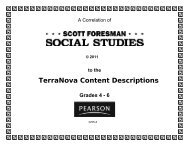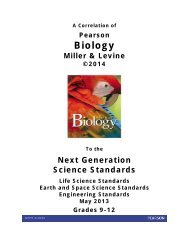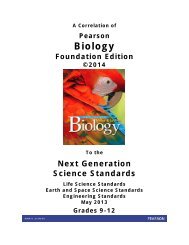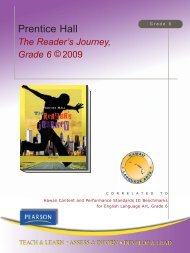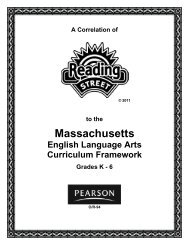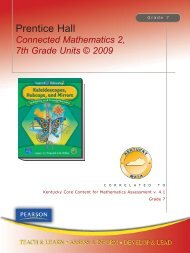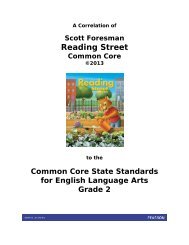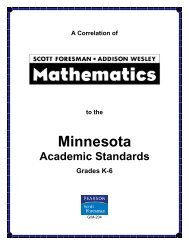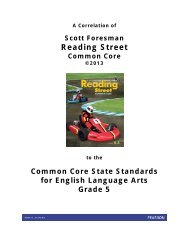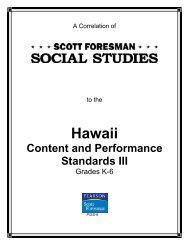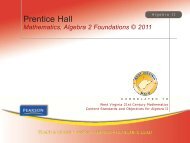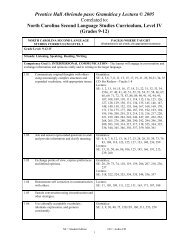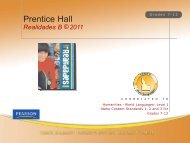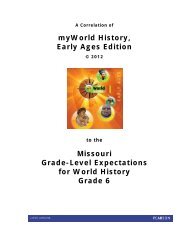Prentice Hall Literature, Grade 10 © 2010 Correlated to ... - Pearson
Prentice Hall Literature, Grade 10 © 2010 Correlated to ... - Pearson
Prentice Hall Literature, Grade 10 © 2010 Correlated to ... - Pearson
You also want an ePaper? Increase the reach of your titles
YUMPU automatically turns print PDFs into web optimized ePapers that Google loves.
<strong>Prentice</strong> <strong>Hall</strong> <strong>Literature</strong>, <strong>Grade</strong> <strong>10</strong> © 20<strong>10</strong><strong>Correlated</strong> <strong>to</strong>:NCTE Standards for the English Language Arts(<strong>Grade</strong> <strong>10</strong>)NCTE STANDARDS FOR THE ENGLISHLANGUAGE ARTS3. Students apply a wide range of strategies <strong>to</strong>comprehend, interpret, evaluate, and appreciatetexts. They draw on their prior experience, theirinteractions with other readers and writers, theirknowledge of word meaning and of other texts,their word identification strategies, and theirunderstanding of textual features (e.g., soundlettercorrespondence, sentence structure,context, graphics).PAGE(S) WHERE TAUGHT(If submission is not a text, citeappropriate resource(s))Reading and vocabulary strategy instructionintroduces and follows every selection, bothfiction and nonfiction. For examples of keyreading strategies see the following:Reading Skill: Prior knowledge, use, 29, 43,55; Credibility, analyze, 182, 187, 1222, 1227;Inference chart, use, 239, 281, 965; Opinionand fact, distinguish, 557, 562, 565, 573;Background knowledge, acquire, <strong>10</strong>91, 1<strong>10</strong>5,1117The Informational Text Workshops alsointroduce reading strategies and emphasize thefeatures and structures of informationalmaterials. For examples, please see:Features, 90–94, Questions, ask/generate <strong>to</strong>extend ideas, 298–304, Details, identifyparaphrase <strong>to</strong>, 402–406, Sequence, examine,512–516, Ideas synthesize and connect, 864–866, Structure and format, analyze, use textfeatures, <strong>10</strong>08–<strong>10</strong>12, Questions, ask/generateinformational texts, 1122–1126Vocabulary Development and Word Study teacha variety of language development skillsincluding using context clues, word parts, andword origins. Examples can be found on thefollowing pages:Vocabulary Development & Word Study: 30,43, 44, 55, 60, 75, 76, 85, 116, 265, 282, 293,336, 355, 356, 365, 382, 397, 462, 471, 472,483, 488, 497, 498, 507, 540, 667, 674, 681,682, 689, 724, 729, 742, <strong>10</strong>01, <strong>10</strong>64, 12174
<strong>Prentice</strong> <strong>Hall</strong> <strong>Literature</strong>, <strong>Grade</strong> <strong>10</strong> © 20<strong>10</strong><strong>Correlated</strong> <strong>to</strong>:NCTE Standards for the English Language Arts(<strong>Grade</strong> <strong>10</strong>)NCTE STANDARDS FOR THE ENGLISHLANGUAGE ARTS4. Students adjust their use of spoken, written,and visual language (e.g., conventions, style,vocabulary) <strong>to</strong> communicate effectively with avariety of audiences and for different purposes.PAGE(S) WHERE TAUGHT(If submission is not a text, citeappropriate resource(s))Students learn <strong>to</strong> develop and adjust spoken,written, and visual presentation skills through anumber of workshops and assignments.Through the Writing Workshops, studentslearn the process of revision as can be seen onthe following pages: Revising: 1<strong>10</strong>, 204, 330,424, 534, 608, 7<strong>10</strong>, 772, 880, <strong>10</strong>25, 1148, 1246Communication Workshops providestructured opportunities for students <strong>to</strong> developand evaluate spoken and visual presentationssuch as these:Analyzing Media Presentations, 212; Viewingand Evaluating a Speech, 432; Delivering aPersuasive Speech, 616; Delivering an OralInterpretation of a Literary Work, 780;Delivering a Multimedia Presentation, <strong>10</strong>36;Comparing Media Coverage, 1254In addition, a variety of writing, research, andlistening and speaking assignments after pairedselections, allow students <strong>to</strong> extend their studyof literature and make connections <strong>to</strong> other realworld issues. Please see the following examples:Writing: Character analysis, 367; Memoir, 509;Critical essay, 731; Edi<strong>to</strong>rial, <strong>10</strong>03; Myth, <strong>10</strong>89Listening and Speaking: Interview, 57, 1251;Humorous persuasive speech, 485; Debate, 555,777; Mock trial, 861; Dialogue, improvised,1119Research and Technology: Researchsummary, 399; Literary his<strong>to</strong>ry report, 731;Biographical brochure, 12195
<strong>Prentice</strong> <strong>Hall</strong> <strong>Literature</strong>, <strong>Grade</strong> <strong>10</strong> © 20<strong>10</strong><strong>Correlated</strong> <strong>to</strong>:NCTE Standards for the English Language Arts(<strong>Grade</strong> <strong>10</strong>)NCTE STANDARDS FOR THE ENGLISHLANGUAGE ARTS5. Students employ a wide range of strategiesas they write and use different writing processelements appropriately <strong>to</strong> communicate withdifferent audiences for a variety of purposes.6. Students apply knowledge of languagestructure, language conventions (e.g., spellingand punctuation), media techniques, figurativelanguage, and genre <strong>to</strong> create, critique, anddiscuss print and non-print texts.PAGE(S) WHERE TAUGHT(If submission is not a text, citeappropriate resource(s))Writing Workshops provide structureassignments that support students through eachstage of the writing process including prewriting,drafting, editing and proofreading andpublishing. Workshops include the following:Au<strong>to</strong>biographical Narrative, <strong>10</strong>8–113; Causeand-EffectEssay, 200–207; Short S<strong>to</strong>ry, 328–333; Problem-and-Solution Essay, 420–427;Letter <strong>to</strong> the Edi<strong>to</strong>r, 532–537; Persuasive Essay,604–611; Descriptive Essay, 708–713;Analytical Response <strong>to</strong> <strong>Literature</strong>, 768–775;Reflective Essay, 878–883; Research Report,<strong>10</strong>20–<strong>10</strong>31; Technical Document, 1146–1151;Comparison-and-Contrast Essay, 1242–1249In addition, students practice the writing processafter paired literary selections with additionalprocess-oriented assignments such as thosefound on the following pages:Writing: Character analysis, 367; Memoir, 509;Critical essay, 731; Edi<strong>to</strong>rial, <strong>10</strong>03; Myth, <strong>10</strong>89Students use spoken, written, and visualpresentation skills through a number ofworkshops and assignments.Communication Workshops providestructured opportunities for students <strong>to</strong> developand evaluate spoken, visual, and mediapresentations such as these:Analyzing Media Presentations, 212; Viewingand Evaluating a Speech, 432; Delivering aPersuasive Speech, 616; Delivering an OralInterpretation of a Literary Work, 780;Delivering a Multimedia Presentation, <strong>10</strong>36;Comparing Media Coverage, 1254Writing assignments in the Writing Workshopsoffer students the opportunity <strong>to</strong> practice usingexpressive literary techniques such as figurativelanguage and <strong>to</strong> practice working within a rangeof genres and structures:Au<strong>to</strong>biographical Narrative, <strong>10</strong>8–113; Causeand-EffectEssay, 200–207; Short S<strong>to</strong>ry, 328–333; Problem-and-Solution Essay, 420–427;Letter <strong>to</strong> the Edi<strong>to</strong>r, 532–537; Persuasive Essay,604–611; Descriptive Essay, 708–713;Analytical Response <strong>to</strong> <strong>Literature</strong>, 768–775;Reflective Essay, 878–883; Research Report,<strong>10</strong>20–<strong>10</strong>31; Technical Document, 1146–1151;Comparison-and-Contrast Essay, 1242–12496
<strong>Prentice</strong> <strong>Hall</strong> <strong>Literature</strong>, <strong>Grade</strong> <strong>10</strong> © 20<strong>10</strong><strong>Correlated</strong> <strong>to</strong>:NCTE Standards for the English Language Arts(<strong>Grade</strong> <strong>10</strong>)NCTE STANDARDS FOR THE ENGLISHLANGUAGE ARTS9. Students develop an understanding of andrespect for diversity in language use, patterns,and dialects across cultures, ethnic groups,geographic regions, and social roles.PAGE(S) WHERE TAUGHT(If submission is not a text, citeappropriate resource(s))The last unit focuses on the Oral Tradition andUniversal Themes. Please see: Unit 6: Themesin <strong>Literature</strong>: Heroism: What is the OralTradition?, <strong>10</strong>48–<strong>10</strong>49; Themes in the OralTradition, <strong>10</strong>50–<strong>10</strong>51; Archetypal NarrativePatterns, 1128; Writing <strong>to</strong> compare archetypalnarrative patterns, 1145; Themes andWorldviews, 1228; Writing <strong>to</strong> compare themeand worldview, 1241In addition, the <strong>Literature</strong> in Context featureprovides background and information that helpsstudents understand the social and culturecontext of the language and issues representedin literature selections. For examples, pleasesee:Culture Connection: Mexican American Pride,503; Ancient Greek Funeral Rites, 844; Griot:The Mind of the People, 1<strong>10</strong>3Geography Connection: Antarctica: TheColdest Place on Earth, 69; Nigerian Civil War,362His<strong>to</strong>ry Connection: San Francisco and theGold Rushes, 83; Babylonian Captivity, The,321; American Revolution, The, 563Humanities Connection: S<strong>to</strong>icism, 976Language Connection: Spanish Vocabulary,274<strong>Literature</strong> Connection: Archaic Word Forms,918Mythology Connection: Roman Society, 9008
<strong>Prentice</strong> <strong>Hall</strong> <strong>Literature</strong>, <strong>Grade</strong> <strong>10</strong> © 20<strong>10</strong><strong>Correlated</strong> <strong>to</strong>:NCTE Standards for the English Language Arts(<strong>Grade</strong> <strong>10</strong>)NCTE STANDARDS FOR THE ENGLISHLANGUAGE ARTS<strong>10</strong>. Students whose first language is notEnglish make use of their first language <strong>to</strong>develop competency in the English language artsand <strong>to</strong> develop understanding of content acrossthe curriculum.11. Students participate as knowledgeable,reflective, creative, and critical members of avariety of literacy communities.PAGE(S) WHERE TAUGHT(If submission is not a text, citeappropriate resource(s))<strong>Prentice</strong> <strong>Hall</strong> <strong>Literature</strong> provides teachers ofEnglish Language Learners a range of notes andassignments in the Teacher’s Edition andTeaching Resources <strong>to</strong> support languagedevelopment.Vocabulary and Reading Warm-ups (whichare Resources referenced in the TE) provideextra support. “A” Warm-ups are for studentsreading two grades below grade level. “B”Warm-ups are for students reading one gradebelow grade level.In addition, the following supportingassignments and notes can be found throughoutthe program along the bot<strong>to</strong>m of the Teacher’sEdition:• Fluency (TE lesson text)• Support for English LanguageLearners (TE lesson text)• Reader’s Notebook English Learner’sVersion (TE referenced resource)Communication Workshops give studentsopportunities <strong>to</strong> develop and practice speakingskills, as well chances <strong>to</strong> discuss presentationsmade by their peers. Workshops include thefollowing:Analyzing Media Presentations, 212; Viewingand Evaluating a Speech, 432; Delivering aPersuasive Speech, 616; Delivering an OralInterpretation of a Literary Work, 780;Delivering a Multimedia Presentation, <strong>10</strong>36;Comparing Media Coverage, 1254Listening and Speaking assignments afterpaired literary selections provide additionalopportunities for discussion and use of listeningskills as can be seen from the followingassignments:Interview, 57, 1251; Problem-solving group,151; Group discussion, 367, 691; Debate, 555,777; Group screening, <strong>10</strong>04Further opportunities for group work exist in theWriting Workshops in which students developPeer Review skills: 204, 424, 608, 772, <strong>10</strong>25,12469
<strong>Prentice</strong> <strong>Hall</strong> <strong>Literature</strong>, <strong>Grade</strong> <strong>10</strong> © 20<strong>10</strong><strong>Correlated</strong> <strong>to</strong>:NCTE Standards for the English Language Arts(<strong>Grade</strong> <strong>10</strong>)NCTE STANDARDS FOR THE ENGLISHLANGUAGE ARTS12. Students use spoken, written, and visuallanguage <strong>to</strong> accomplish their own purposes(e.g., for learning, enjoyment, persuasion, andthe exchange of information).PAGE(S) WHERE TAUGHT(If submission is not a text, citeappropriate resource(s))Students use spoken, written, and visualpresentation skills through a number ofworkshops and assignments.Communication Workshops providestructured opportunities for students <strong>to</strong> developand evaluate spoken and visual presentationssuch as these:Analyzing Media Presentations, 212; Viewingand Evaluating a Speech, 432; Delivering aPersuasive Speech, 616; Delivering an OralInterpretation of a Literary Work, 780;Delivering a Multimedia Presentation, <strong>10</strong>36;Comparing Media Coverage, 1254In addition, a variety of writing, research, andlistening and speaking assignments after pairedselections, allow students <strong>to</strong> extend their studyof literature and make connections <strong>to</strong> other realworld issues. Please see the following examples:Writing: Character analysis, 367; Memoir, 509;Critical essay, 731; Edi<strong>to</strong>rial, <strong>10</strong>03; Myth, <strong>10</strong>89Listening and Speaking: Interview, 57, 1251;Humorous persuasive speech, 485; Debate, 555,777; Mock trial, 861; Dialogue, improvised,1119Research and Technology: Researchsummary, 399; Literary his<strong>to</strong>ry report, 731;Biographical brochure, 1219<strong>10</strong>



